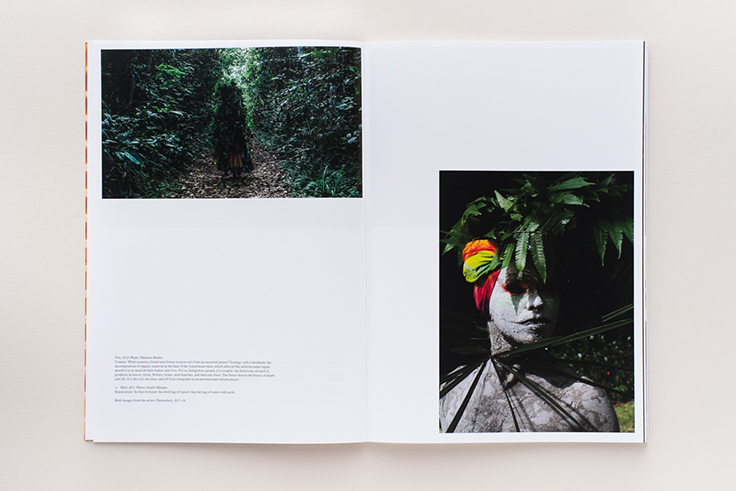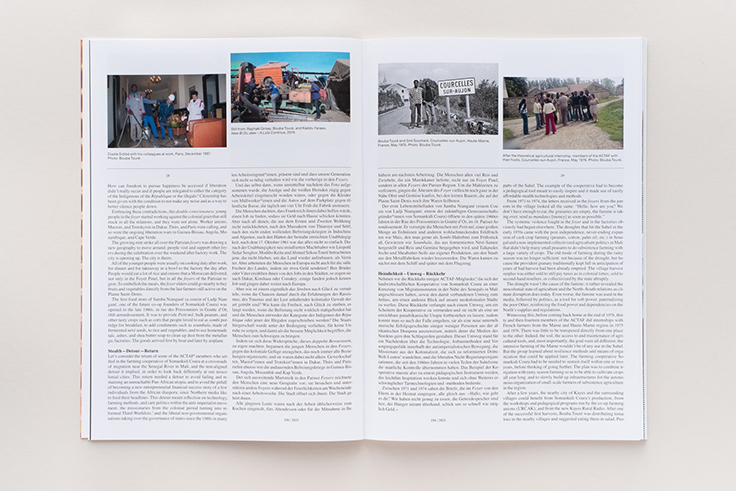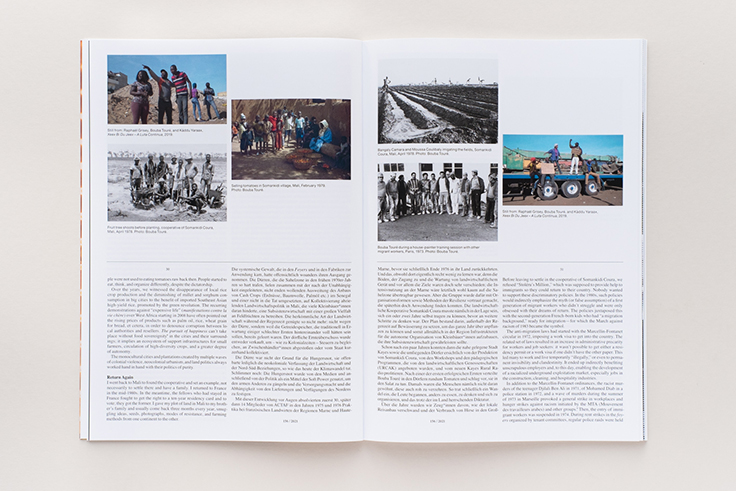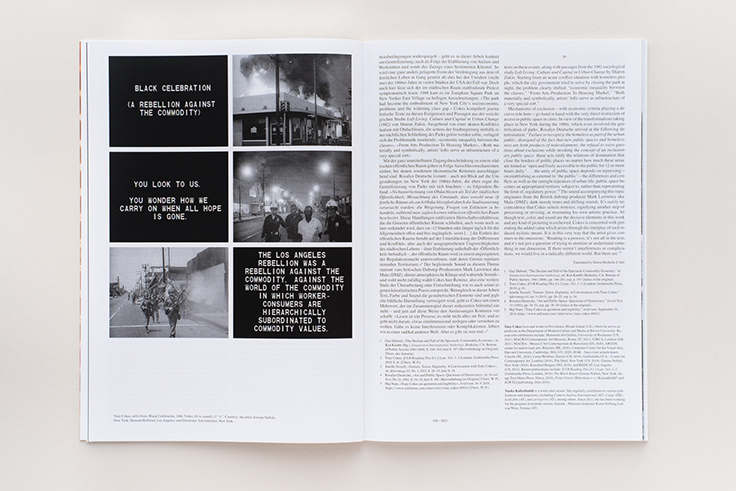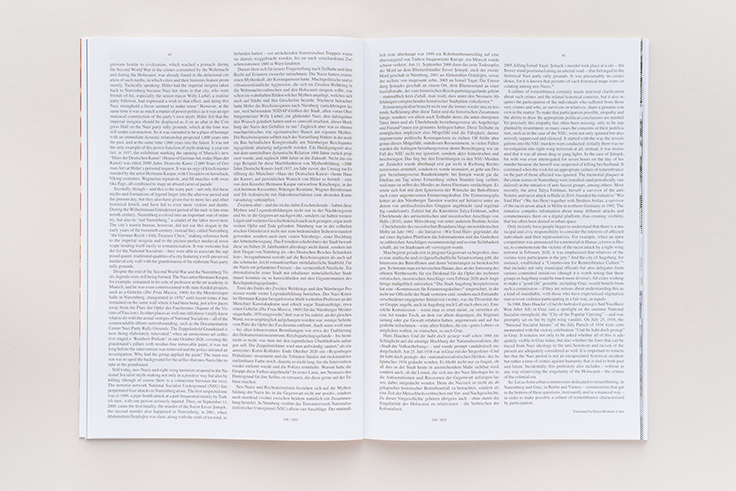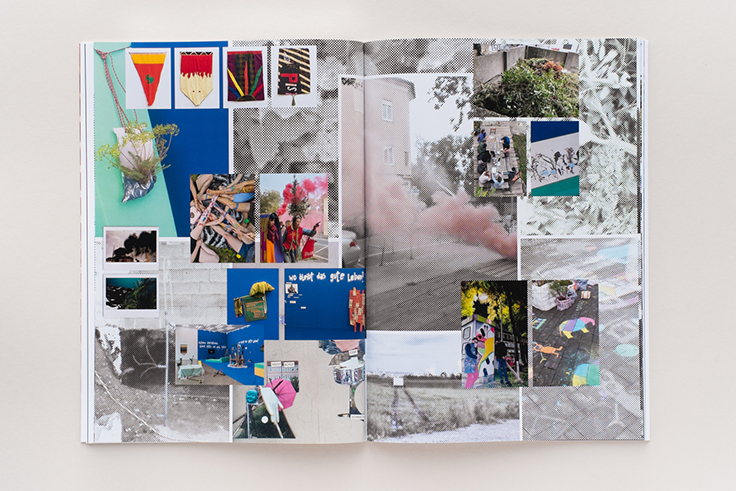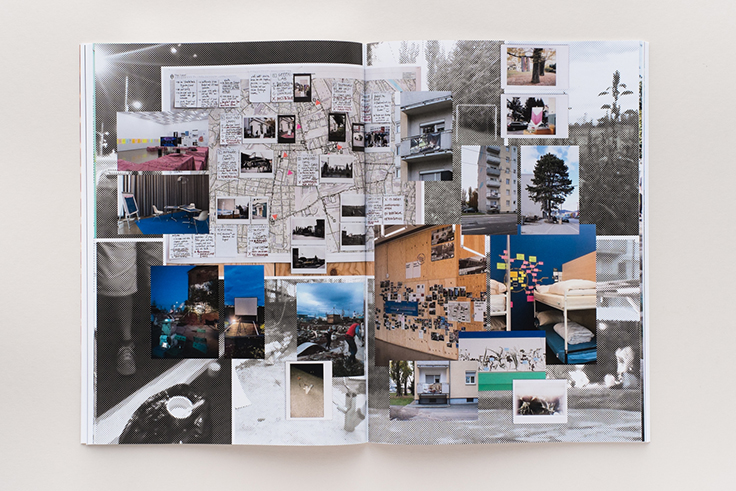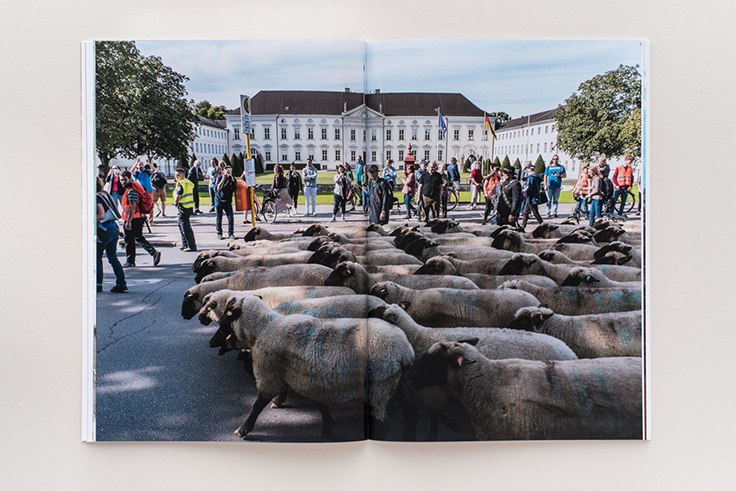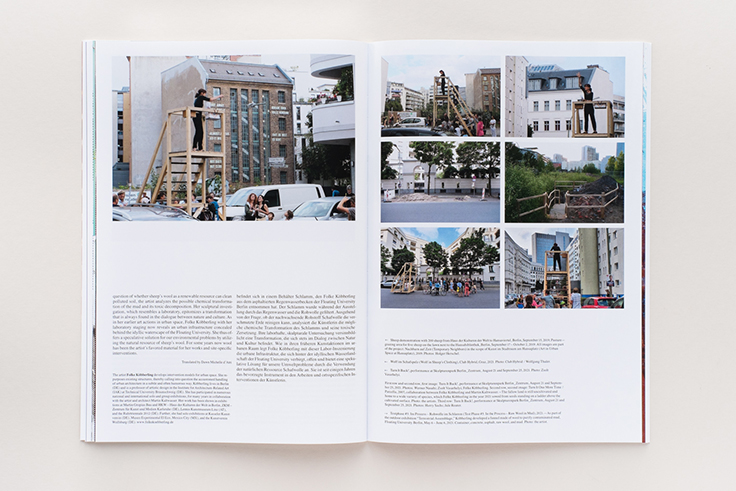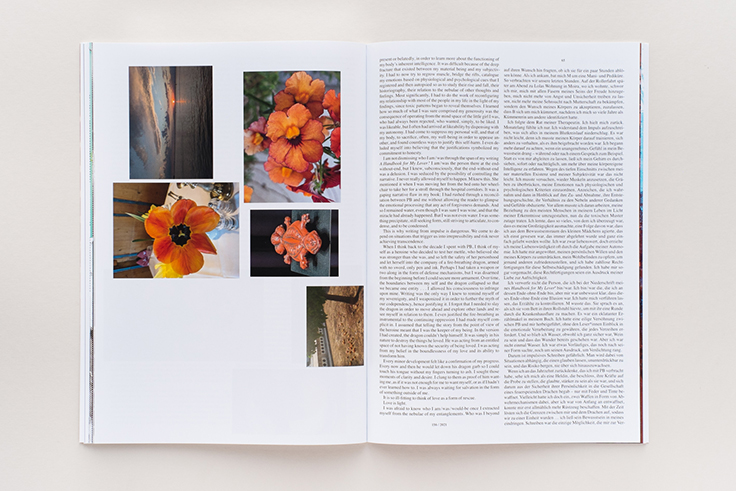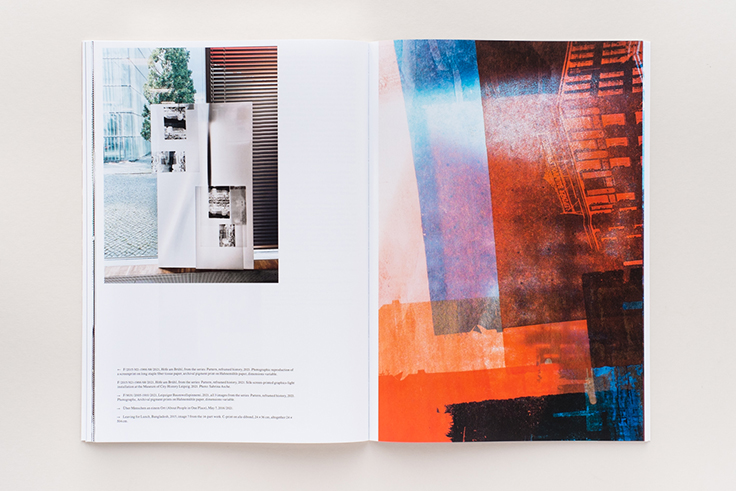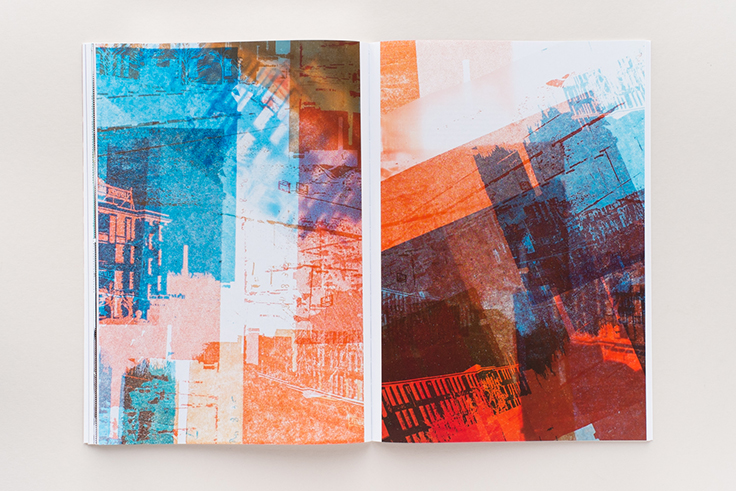Camera Austria International
156 | 2021
- UYRA SODOMA
Re-enchanting Life - LEANNE BETASAMOSAKE SIMPSON
Mino-Bimaadiziwin: The Good Life - RAPHAËL GRISEY / BOUBA TOURÉ
Happiness Against the Grain - TONY COKES / NAOKO KALTSCHMIDT
Urban Protests and Negative Spaces: Displacement from Public Life - JÖRG HEISER
No Good Life without Remembrance - NICOLE SIX & PAUL PETRITSCH
Echo Space: A Sphere of Activity and Agency - FOLKE KÖBBERLING
Temporary Neighbors - ROSALYN D'MELLO
Die Metamorphose
- SABRINA ASCHE
About People in One Place
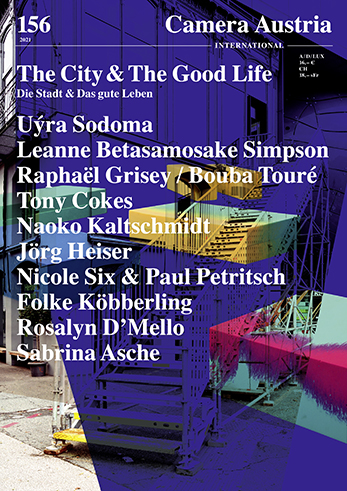
Preface
In a time of environmental degradation, wasted resources, and political inaction, thinking about a “good life” seems nearly impossible. Camera Austria nevertheless responded to the call for tenders by the City of Graz within the framework of Graz Kulturjahr 2020 with the project The City & The Good Life, which was conceived by the entire board of the association and developed in close collaboration with Daniela Brasil. It was finally able to begin in September 2020 and came to an end in May 2021 with the exhibition curated by Urban Subjects If Time Is Still Alive. This project—among many other, in part surprising experiences—clearly showed how very localized urbanities are constructed and composed, are fragmentary and at times fleeting, and that many of them exist in parallel without necessarily perceiving or knowing very much about each other. The urban here and now is difficult to demarcate, since social media, streaming services, and online shops connect us with all kinds of cultural, aesthetic, and political ideas. People talk about a possible city in common in different languages, and such a city is designed with a wide range of concepts. These different designs, requirements, aspirations, and disappointments resonated in the Echoraum (Echo Space) by Nicole Six & Paul Petritsch. . . .
This issue of our magazine attempts neither to document the loss of the idea of a city in common or a good life, nor reconcile us with this loss. Within the framework of the project The City & The Good Life, we tried to initiate processes that would at least provide ideas about possibilities for reclaiming and re-appropriating them again in another form. In the invitation to the artists and authors in this issue, we thus correspondingly wrote: “What resources, networks, and opportunities to partake of a good life in the city have been neglected as a result of the predominantly economically oriented hierarchies of the neoliberal city? . . . Against what regulations and governing techniques will this idea of a good life have to be demanded more intensively in the future?”
Read more →Camera Austria International 156 | 2021
Preface
In a time of environmental degradation, wasted resources, and political inaction, thinking about a “good life” seems nearly impossible. Camera Austria nevertheless responded to the call for tenders by the City of Graz within the framework of Graz Kulturjahr 2020 with the project The City & The Good Life, which was conceived by the entire board of the association and developed in close collaboration with Daniela Brasil. It was finally able to begin in September 2020 and came to an end in May 2021 with the exhibition curated by Urban Subjects If Time Is Still Alive. This project—among many other, in part surprising experiences—clearly showed how very localized urbanities are constructed and composed, are fragmentary and at times fleeting, and that many of them exist in parallel without necessarily perceiving or knowing very much about each other. The urban here and now is difficult to demarcate, since social media, streaming services, and online shops connect us with all kinds of cultural, aesthetic, and political ideas. People talk about a possible city in common in different languages, and such a city is designed with a wide range of concepts. These different designs, requirements, aspirations, and disappointments resonated in the Echoraum (Echo Space) by Nicole Six & Paul Petritsch.
But why should we hold fast to the concept of city at all? The notion of a buen vivir, which is closely connected with the struggle of indigenous peoples in the Americas to preserve their cultural spheres and their nature as well as to participate in political processes, points to very different concepts of social coexistence. Hailing from the north shore of Lake Ontario, Michi Saagiig Nishnaabeg author Leanne Betasamosake Simpson reminds us that translating concepts is questionable, because specific contexts and also the particular history of these concepts get lost as a result. “Mino-Bimaadiziwin” can thus mean not only “good life,” but also, according to a translation by Winona LaDuke, “continuous rebirth”—living a life in order to produce more and not only human life. This also denotes imagining a different organization of life and world.
This issue of our magazine attempts neither to document the loss of the idea of a city in common or a good life, nor reconcile us with this loss. Within the framework of the project The City & The Good Life, we tried to initiate processes that would at least provide ideas about possibilities for reclaiming and re-appropriating them again in another form. In the invitation to the artists and authors in this issue, we thus correspondingly wrote: “What resources, networks, and opportunities to partake of a good life in the city have been neglected as a result of the predominantly economically oriented hierarchies of the neoliberal city? . . . Against what regulations and governing techniques will this idea of a good life have to be demanded more intensively in the future?” In order to decide what role care, participation, the common good, diversity, and community initiatives can play and what new social formations this requires, the city still continues to be conceived as a—if also unmanageable—unit that might emerge through the efforts of all of us. But how globally and universally is this city imagined? Don’t we fundamentally have to bid farewell to ideas of the universal, because they have in any case never really encompassed everyone everywhere? “You came over during colonization to extract our bodies and our land, you gave us papers in order to enroll us by force in your wars. We came back to recall what has been plundered and stolen from us . . . We are French as much as you and we will fight for our rights and not remain your Indigenous Other within the République,” propose Raphaël Grisey and Bouba Touré as a possible message of a portrait of two friends from Mali in front of Foyer Pinel, set in Saint-Denis in the north of in Paris in 1971. Another might be: “We arrived well in France, as you can see, we can now dress up the Western way, believe it or not, this is the sign if not the symbol of our economic success, we are well and will send money as soon as possible to support the village.” There could not be a greater distance between modalities, a shared communal space, and designing one’s own role in it: economic success or developing new rules, participation versus revolution. This distance, however, also points to how many do not participate at all—and perhaps will not do so for a long time—in the production of our societies and public spaces, whose permanent legal residency is impeded, and whose visibility, as well as simultaneously their pressing concerns, disappears once again between the moments of public awareness that result from demonstrations.
In her text on Tony Cokes, Naoko Kaltschmidt considers the question of “negative spaces.” When Tompkins Square Park in New York City’s East Village was supposed to be closed at night in order to rid the district of socioeconomic problems, there were fierce conflicts. Such measures reinforce existing mechanisms of domination and exclusion and public space increasingly disappears. In his video installations, Cokes himself develops a method of confrontational aesthetics that again and again enables him to address such emerging conflicts.
Sabrina Asche sits in a public square in front of a shopping center in Leipzig. An Asian woman is trying to sell roses. The conversations overheard revolve around shopping. “130 Euro—I could have shopped ’til I dropped.” The always similar-looking shopping bags catch her eye. The whole tragedy of production in low-wage countries and the hunt for bargains in Europe plays out between the consumers and the rose seller. The seemingly incidental recording of interactions between the “people in one place” like this indicates their political and economic entanglements in a striking way. Uýra Sodoma’s interests are directed at the tragedy of exploitation and affluence in a quite different way. In performative stagings for the camera, futuristic beings merge with indigenous ancestors in one person, and the connection to nature directly collides with its destruction. The places visited have been shaped by the history of their being invaded by Eurocentric culture, but have been abandoned or left behind, re-conquered by nature, like a recurring memory.
The contribution by Jörg Heiser also deals with memory and history. “The right to a good life in the city implies, I would suggest, the right to remember.” Participation in the present is only possible for Heiser if it is guaranteed by a shared history. This “real participation must take all of those into account who, in the past and in the present, have been marginalized, stigmatized, persecuted, or who even have risked life and limb and been destroyed; the survivors, the family and friends, those who found themselves in the resulting radius of shock and trauma.” In line with this, he advocates for “Commissions for Remembrance Culture” in every city to jointly measure this radius.
“I have only to unfold my mouth to speak to see the notes of slight revulsion on the face of my immediate listener. They don’t know what to make of the elaborate birthmark that occupies the left tip [of my tongue]. I think of my tongue as a frontier, the first line of resistance to that which it is not habituated.” Rosalyn D’Mello writes about a sort of existential foreignness that not only separates her from others, but also has not allowed her “to happen” for a long time. “I had come to suppress my personal will, and that of my body, to sacrifice, often, my well-being in order to appease another, and found countless ways to justify this self-harm.” This difficult path from autonomy to love is ultimately also based on the fundamental question of a “being-in-common,” of a coexistence with others. Jean-Luc Nancy proposes concentrating our efforts around this “with” and conceiving a community without things in common, which might be one of the foundations of a good life.
Folke Köbberling’s urban interventions raise the question of how space and resources in public spaces are allocated, and address the lack of green space, but also the absence of public debate on how a reallocation might be initiated. Sheep as Nachbarn auf Zeit (Temporary Neighbors, 2019) and an embodiment of the absence of nature in cities formed a catalyst for the space for social interaction that arose through caring for the sheep—all of these aspects revolve directly around the question of a good life in the city.
The insert by Nicole Six & Paul Petritsch is the only contribution that comes directly from the The City & The Good Life project already mentioned, but does not pursue any documentary interests. The contribution clearly presents numerous subprojects, frequently minimal interventions—and a certain disinterest in art—even though the central structure of the project was based on an artistic conception. The contribution also elucidates the diverging dynamics of the project as a whole, the explorations in different directions, and nowhere near all of the fields of activity that emerge from this were intended to be represented. One of the starting questions also concerned the role of politics of representation and the form in which they possibly impede the production of shared public spheres. Is it possible to come up with a notion of visual representation that does not aim at wanting to make everything visible? Is it possible to conceive a relationship between picture and public sphere that is not defined by making-visible, showing, and describing?
Ubuntu (the name of a Linux operating system)—a word borrowed from the Zulu and Xhosa languages of South Africa—has the following meaning: “I am what I am, thanks to what we all are.” (Václav Bĕhloradský) A more apt formulation of being-with, as has already been mentioned, is almost impossible to imagine. The essential basis of a good life is thus perhaps also outlined when basis does not denote a joint foundation, but rather agreeing on an ongoing, mutually critical upheaval. The incoherence of this issue is perhaps its greatest strength: searching for the traces of what we all are where they are to be found, in remote places, as part of conflicting practices, and as remembering the tradition of defending the rights of all individuals to critically reject the societies, cities, the cultures, and genders into which they are born—in order to find out what we all could be.
As part of this special issue the mini-poster that has meanwhile become a tradition for the last issue of the year is enclosed for subscribers. We are exceptionally pleased by the collaboration with Folke Köbberling, who selected a motif from her archive for the poster. With this supplement, we would also like to thank you for your loyalty and long-term support of our work.
Reinhard Braun and the Camera Austria Team
November 2021
Cover: Nicole Six & Paul Petritsch, Site-Specific (Public) Lessons, in the scope of The City & The Good Life, Graz Kulturjahr 2020, 2020–21. Collage by Till Gathmann based on installation views by Markus Krottendorfer, 2021.
Entries
Exhibitions
Biennale für Freiburg: BfF #1
Verschiedene Orte, Freiburg im Breisgau, 10. 9. – 3. 10. 2021
WALTER SEIDL
The Politics of a Liminal Place
steirischer herbst – The Way Out
Various venues, Graz and environs, 9. 9. – 10. 10. 2021
LARA SCHOORL
Art Club2000: Ausgewählte Werke 1992 – 1999
Kunsthalle Zürich, 18. 9. 2021 – 16. 1. 2022
Artist Space, New York, 22. 10. 2020 – 30. 1. 2021
SØNKE GAU
Female Sensibility: Feministische Avantgarde aus der SAMMLUNG VERBUND
Lentos Kunstmuseum Linz, 24. 9. 2021 – 9. 1. 2022
VANESSA JOAN MÜLLER
Massao Mascaro: Sub Sole
Fondation A Stichting, Brussels, 25. 9. – 19. 12. 2021
STEVEN HUMBLET
Shiraz Bayjoo: La Sa La Ter Ruz
Fondation H, Paris, 16. 9. – 20. 11. 2021
MICHÈLE COHEN HADRIA
Cristina Lucas: Maschine im Stillstand
Kunstsammlungen Chemnitz, 15. 8. – 31. 10. 2021
MITCH SPEED
Felix Dreesen: Von Wolkenschäden
GAK – Gesellschaft für aktuelle Kunst, Bremen, 28. 8. – 24. 10. 2021
RAINER UNRUH
Aglaia Konrad: Japan Works and Other Books
Enter Enter – A Space for Books, Amsterdam, 11. 9. – 10. 10. 2021
REINHARD BRAUN
L’image et son double
Galeries de photographie – Centre Pompidou, Paris, 15. 9. – 13. 12. 2021
NINA STRAND
Primrose: Early Colour Photography in Russia, 1860s–1970s
MAMM – Multimedia Art Museum, Moscow, 2. 9. – 5. 12. 2021
AGNIESZKA GRATZA
Margot Pilz: Selbstauslöserin
Kunsthalle Krems, 23. 10. 2021 – 3. 4. 2022
CHRISTINA NATLACEN
Pauline Curnier Jardin: WAITING FOR AGATHA, SEBASTIAN AND THE REST OF THE HOLY CHILDREN—UNFOLDING A FILMIC RESEARCH
Index – The Swedish Contemporary Art Foundation, Stockholm, 2. 9. – 13. 12. 2021
ASHIK and KOSHIK ZAMAN
Moderne Zeiten: Industrie im Blick von Malerei und Fotografie
Bucerius Kunst Forum, Hamburg, 26. 6. – 26. 9. 2021
PAUL MELLENTHIN
… oder kann das weg? Fallstudien zur Nachwende
nGbK – neue Gesellschaft für bildende Kunst, Berlin, 16. 9. – 17. 11. 2021
JANA NORITSCH
Ana Hoffner ex-Prvulovic* & Belinda Kazeem-Kamiński
Kunsthalle Wien, 22. 10. 2021 – 6. 2. 2022
BETTINA LANDL
Books
Talking Books
Erik van der Weijde in Conversation with . . . Mike Slack
Mike Slack: OK OK OK
J&L Books, Atlanta / New York 2002
Mike Slack: THE TRANSVERSE PATH (Or Nature’s Little Secret)
The Ice Plant, Los Angeles 2017
Elisabeth Neudörfl, Out in the Streets
Hatje Cantz, Berlin 2021
CAROLIN FÖRSTER
Katja Stuke & Oliver Sieber, Paris, 8. Dec 2018. La Ville Lumière
Boehm Kobayashi, Köln; Éditions GwinZegal, Guingamp 2021
SABINE MARIA SCHMIDT
DISCOURSE
MACK, London, 2020–ongoing
MARINUS REUTER
Imprint
Publisher: Reinhard Braun
Owner: Verein CAMERA AUSTRIA. Labor für Fotografie und Theorie.
Lendkai 1, 8020 Graz, Österreich
Editor-in-Chief: Christina Töpfer.
Editor: Margit Neuhold.
Translations: Dawn Michelle d’Atri, Nicholas Huckle, Amy Klement, Peter Kunitzky, Wilfried Prantner, Alexandra Titze-Grabec.
English Proofreading: Dawn Michelle d’Atri.
Acknowledgments: Sabrina Asche, Daniela Brasil, Tony Cokes, Jörg Dittmer, Florian Ebner, Raphaël Grisey & Bouba Touré, Jörg Heiser, Sarah Maria Kaiser, Naoko Kaltschmidt, Jelena Kalu-djerović, Peter Kunitzky, Folke Köbberling, Andrej Krementschouk, Marissa Lobo, Ivana Marjanović, Rosalyn D’Mello, Christina Natlacen, Ulrike Otto, Heidi Pretterhofer, Michael Rieper, Philip Schütz, Leanne Betasamosake Simpson, Nicole Six & Paul Petritsch, Franziska Schmidt, Eduardo Sotomayor, Katja Stuke & Oliver Sieber, Urban Subjects (Sabine Bitter, Jeff Derksen, Helmut Weber), Uýra Sodoma.
Copyright © 2021
No parts of this magazine may be reproduced without publisher’s permission.
Camera Austria International does not assume any responsibility for submitted texts and original materials.


